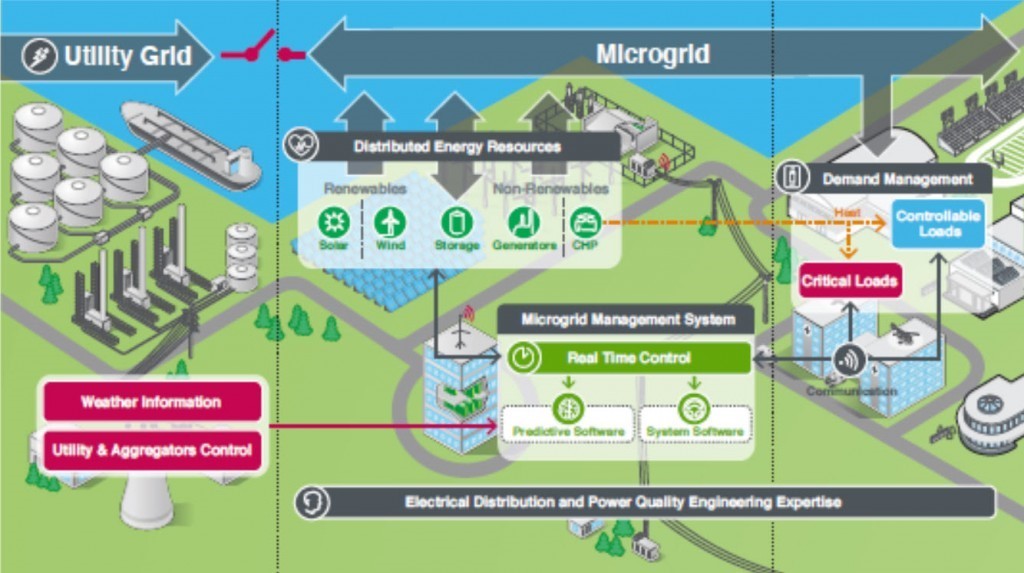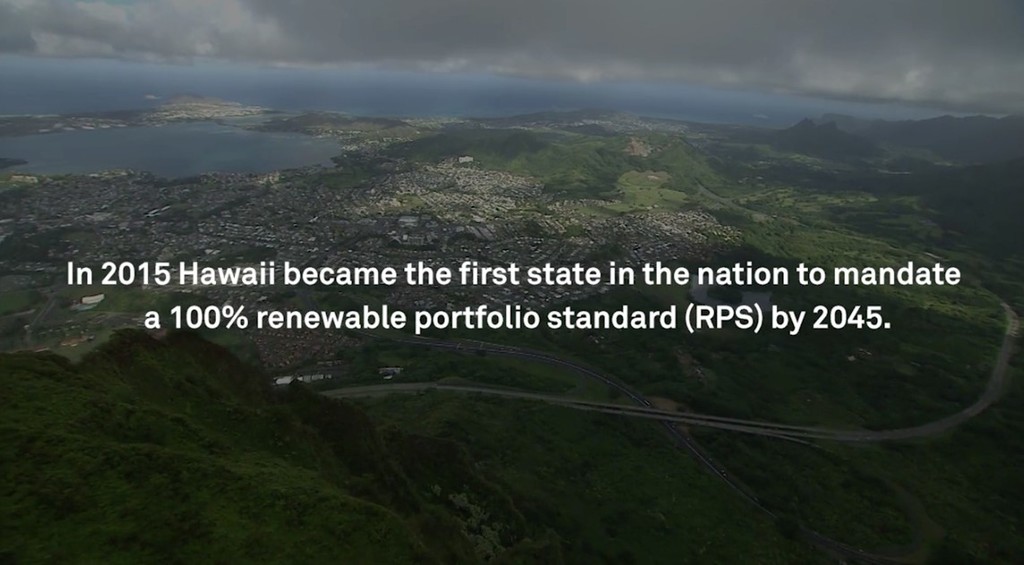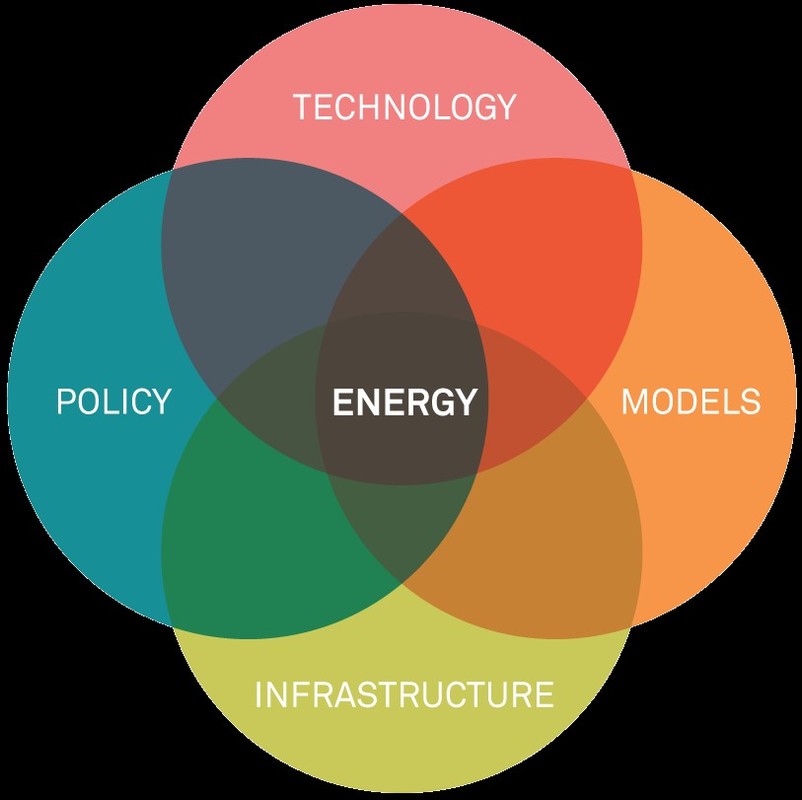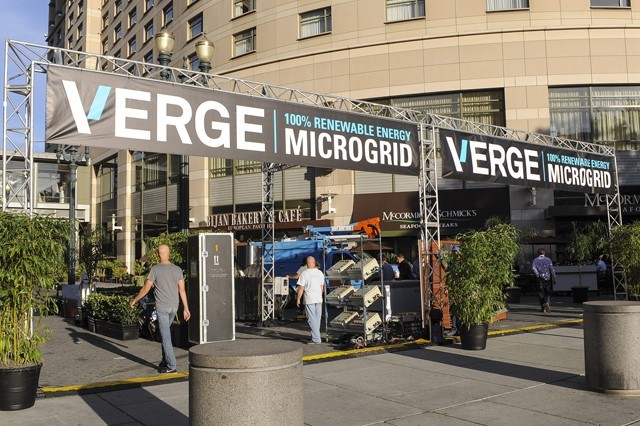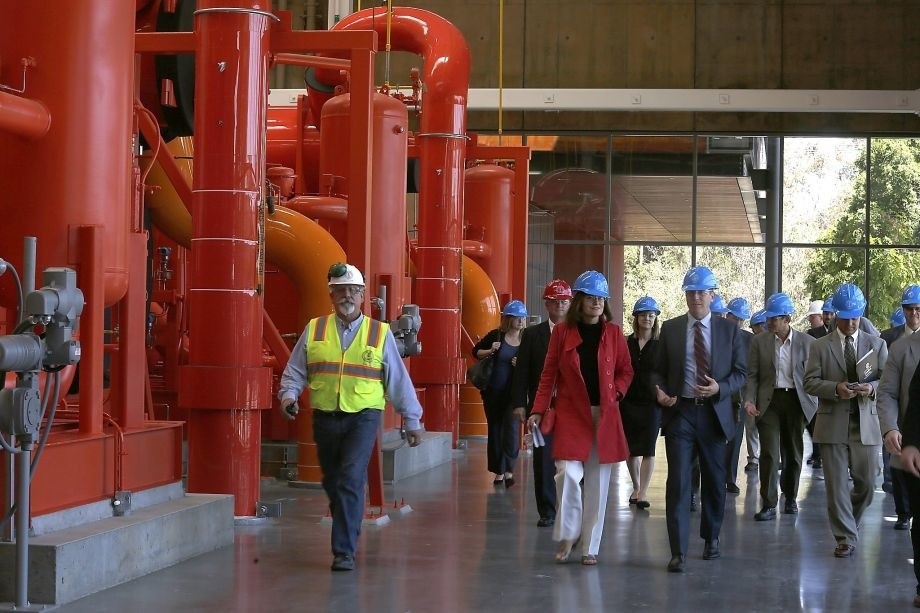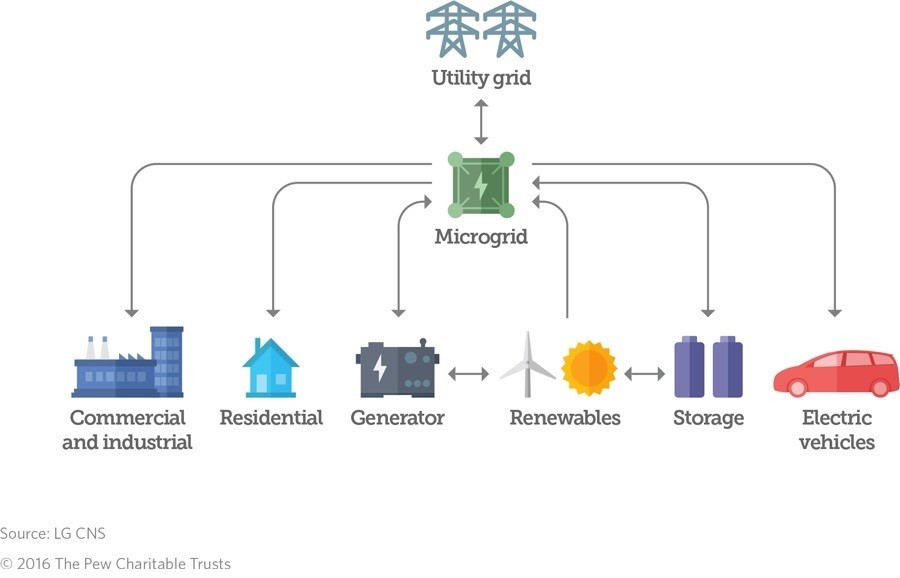Late last month, the Asia Pacific hosted two very important and starkly contrasting international conferences on the region’s energy and climate choices. A very high level, invitation-only summit in Singapore declared that the region’s energy options are limited to choosing from a mix of coal, gas and nuclear, with renewable energy’s role merely marginal. But a far more diverse and innovative conference in Honolulu, one that included the US military, demonstrated that renewable energy is the region’s economically and environmentally rational choice. As we shall see, there was one key difference between these polarized positions on what is perhaps the single most important issue of our era. The Singapore event focused on the supply side of energy whereas the Hawaii summit examined the energy system in its entirety. The Hawaii event paid particular attention to the increasingly crucial role of microgrids and other enabling infrastructures that reshape the demand side as well as the supply side. This short article reviews both events and asks why the Singapore summit ignored the role of smart networks. We then conclude by showing how smart infrastructures are becoming central to climate-change mitigation and adaptation.
But let us begin by at least loosely defining microgrids, as this article refers repeatedly to them and they are hardly a familiar technology. As depicted in the attached figure, “A Typical Microgrid,” the microgrid is a local network infrastructure that usually “functions somewhat like the large electric grid, but serves a much smaller footprint. It provides energy for one or more customers within a contained boundary, and it typically operates multiple sources of power generation and possibly heating and cooling, and includes the wires and pipes to deliver the energy. It also may include energy storage and electric vehicles.”1 Equipped with smart monitoring and controls, microgrids can dramatically change both the supply and demand sides. Microgrids can help communities maximize their use of renewable energy as well as minimize their consumption of energy overall.
The Pacific Energy Summit in Singapore
The assertion that renewable energy is at best a sideshow in the Asia Pacific set the tone in Singapore, where the influential US National Bureau of Asian Research (NBR) held its 7th “Pacific Energy Summit,” from June 20-22.2 The summit brought together “a high-level group of leaders from policy, industry, and academia” to debate this year’s theme of “Sustainable Futures: Energy and Environmental Security in Times of Transition.”
The NBR is a non-profit think tank that shapes much mainstream thinking on Asia. Its event was co-sponsored by conventional-energy heavyweights Chevron and Exxon Mobil, two US firms that the June 28, 2016 Financial Times spotlighted as curiously unwilling to join their European counterparts in committing to a climate-change pact to help keep global temperatures below 2°C.3 Additional collaborators for the NBR’s Singapore meeting included partnership with the Asia Development Bank and support from the Sustainable Energy Association of Singapore. Somewhat at odds with the preferences of its big-oil co-sponsors, the NBR promoted its event by highlighting last December’s Paris COP21 climate meeting, where global leaders agreed to work towards restricting the planetary temperature increase to under 2°C. Yet choosing Singapore as the conference venue was appropriate: though Singapore is at present almost wholly reliant on natural gas for power, it is a “smart nation” whose initiatives include developing microgrids and renewables as well as attracting “the renewable energy desks of financial organisations to use Singapore as the springboard to serve Asia.”4
Previous NBR energy summits have been held in Beijing (2015), Seoul (2014), Vancouver (2013), Hanoi (2012), Jakarta (2011), and Tokyo (2009), with no event having been held in 2010. All the earlier summits have been followed up with very professional and detailed summary reports and related information, including audio files.5 However, as of this writing no summary report and audio files are available for the Singapore meeting. In consequence, we have to assess the 2016 event’s overall tone on energy options and sustainability from the information currently made available. Fortunately, prior to the conference, the NBR uploaded several working papers for presentation, along with a number of “summit briefs.” These documents remain available at the conference website, and provide a window into the conference as well as much food for thought. Notably, none of them portrays renewable energy as a significant option for the region’s electricity and primary-energy portfolios. And that downplaying of renewables is generally the case with documents from the previous NBR energy summits.
Among the 2016 summit’s working papers and briefs, the most interesting, and most prominently publicized by the NBR (through a pre-summit e-mail distribution on June 3), is a working paper by Mark C. Thurber. Thurber is Associate Director (for research) of the Program on Energy and Sustainable Development at StanfordUniversity. In his “Coal, Gas, or Nuclear: Asia’s Inconvenient Energy Choice,” Thurber is very dubious about the prospects for renewable energy as well as the scenarios favoured by its “environmental NGO” supporters.6
The Inconvenient Choice
Thurber’s arguments are well-grounded in dismaying empirical fact, especially the enormity of our current energy consumption and the dominance of fossil fuels in supplying it. He begins by outlining the conspicuous role of carbon-intensive coal, both globally and in Asia’s energy portfolio. Drawing on International Energy Agency (IEA) statistics, from its 2015 World Energy Outlook, Thurber notes that in 2013 coal provided 29 percent of global primary energy demand and 41 percent of electric power generation, the latter share exceeding any other energy source. Thurber adds that in spite of crippling environmental costs, coal remains attractive to emerging economies because it is cheap, requires only modest infrastructure deployments, is plentiful and widely distributed, and provides reliable 24/7 “baseload” power generation. Indeed, Thurber cites IEA predictions that coal use appears likely to increase by 11 percent between 2013 and 2040. The data also show that Asia was responsible for 71 percent of global coal consumption, far greater than the region’s 54 percent share of global population and 38 percent share of global GDP. The IEA further suggests that by 2040, Asia’s share of global coal consumption could reach roughly 80 percent.
Thurber’s IEA data on the growing role of coal in global energy are confirmed by the British Petroleum (BP) Statistical Review of Energy 2015, as shown in the attached figure on “Global energy use by source.” Moreover, recent research on the worrisome “renaissance of coal” by climate-energy specialists adds weight to Thurber’s arguments.7
Thurber warns that the projected increase in coal consumption, if it comes to pass, will put any reasonable climate goals in serious jeopardy. He then turns to the coal industry and environmental NGOs’ plans for avoiding climate catastrophe. As Thurber portrays it, the coal industry argues that carbon capture and storage (CCS) technology can restrict the release of carbon dioxide, whereas the environmental NGOs insist that coal’s role can be replaced by wind and solar.
Thurber directs powerful criticisms at both of these positions. First, he shows that the coal industry’s solution is not credible because “CCS is just too expensive as an add-on to an energy source whose main attraction is its low cost, and recent demonstration projects have experienced serious cost overruns and performance problems” (p. 3). Thurber’s critique cuts through a great deal of wishful thinking about the prospects for CCS. And given the context in which Thurber presented his paper, his argument was admirably bold: it rebuts the corporate policy of summit co-sponsor Exxon Mobil. The latter declares that it already does CCS in its enhanced oil recovery operations and that “CCS may well become a viable and important emissions reduction option in the near future in large part due to what ExxonMobil is doing today.”8
Thurber then takes up the question of whether renewables can displace coal, concluding that the answer is no. He contends that renewables are more costly than coal and not yet ready to scale up and provide the prodigious amounts of energy needed to substitute for coal. He also believes renewables are incapable of acting as a baseload power source due to their intermittency, since solar and wind facilities often do not generate power or do so unsteadily. Thurber goes on to examine the mix of institutions and policies that have shaped individual countries’ energy profiles, and what might be done to shift them towards greater reliance on lower-carbon gas and nuclear alternatives. His paper is fascinating and informative, and deserves a wide reading.
Thurber’s position on renewables, which evidently framed the NBR event, is worth quoting at length. He declares that “[o]ver at least the next twenty years, the carbon emissions of the energy sector—and especially the energy sector in Asia—will on the supply side be shaped most importantly by the competition between coal, natural gas, and nuclear energy. This basic fact is inconvenient and therefore often goes unacknowledged. Environmental groups tend to breezily assert thatreplacing coal with renewables is straightforward and cost-effective.The general public wouldalso prefer to believe that renewables can solve all our problems such that difficult choices arenot necessary. Governments in countries with strong antinuclear movements, like Germany and Japan, do not draw attention to the fact that nuclear phase-outs go hand in hand with growth in the share of fossil fuels.” (pp. 3-4).
The above claims leave ample room to nitpick, of course. For example, it is true that Germany’s reliance on coal and natural gas did increase right after the 2011 decision to withdraw from nuclear by 2022. But as shown in the attached figure on “Where Germany Gets Its Electricity,” the reliance on coal as well as natural gas in the power mix have both resumed their long-range decline since 2012-2013. Also, the BP Statistical Review of Energy June 2016 indicates that German coal consumption for all purposes (e.g., industrial heat as well as electricity generation) went from 78.3 million tonnes oil equivalent (MTOE) in 2011 to a peak of 82.8 MTOE in 2013, before falling back to 78.8 MTOE in 2014 and 78.3 MTOE in 2015.9
And contrary to what Thurber suggests, in writing that the Japanese government does not “draw attention to the fact that nuclear phase-outs go hand in hand with growth inthe share of fossil fuels,” the Japanese government is not committed to a nuclear phase-out. Japan’s official energy policy, the Strategic Energy Plan, was revised in April of 2014, and in July of 2015 explicit targets were added for the country’s 2030 power mix. As shown in the attached figure on “Japan’s Changing Power Mix,” these targets saw the anticipated role of nuclear downgraded to roughly 20% of power generation by 2030. Though this reduced nuclear target is a profound retreat from the over 50% figure (by 2030) envisioned in the 2010 Strategic Energy Plan, it is not a phase out. Moreover, the Japanese government has been very vocal, for years, in warning that the idling of virtually all the country’s nuclear fleet since 2011 has led to a massive increase in the reliance on fossil fuels. For example, Japan’s 2016 Energy White Paper, released in June, warns that the role of fossil fuels rose from 61.7% of the power mix in 2009 to 87.7% in 2014.10
But for our purposes here, Thurber’s most important claim is that there are serious weaknesses in the environmental NGOs’ outline of a renewable alternative. Certainly it is true that many environmental NGOs do not offer persuasive roadmaps for restructuring the power economy, especially at a speed commensurate with their insistence that fossil fuels and nuclear be abandoned promptly. The NGOs’ audience is often well-meaning citizen groups who, as Thurber suggests, just want to see more solar panels and wind farms. Hence, far too many NGO reports and conference presentations merely recite optimistic scenarios based on targets that are deemed technically possible, given average levels of insolation, wind-speed, and the like. The bulk of these energy visions omit serious discussion of the massive lifestyle and governance changes, infrastructural investments, and other unparalleled heavy-lifting required to achieve a quick shift to renewable energy as the basis of electricity generation, transport, industrial processes, and the myriad other aspects of the energy economy.
So to some extent, Thurber’s criticism is on the mark. In fact, the problem of hortatory rather than critical thinking on energy is so acute that, also in June, highly regarded energy experts Richard Heinberg and David Fridley released their very readable Our Renewable Future: Laying the Path for One Hundred Percent Clean Energy. They also made the book freely available (though the present author ponied up for a Kindle copy, and so should you).11 As the book’s title makes clear, Heinberg and Fridley favour renewable energy, but they are hardly cheer-leaders. Rather, their work is a rigorous analysis of the various components – including power, transport, food – of the overall energy system, and the daunting challenges involved in supplanting the deeply entrenched role of fossil fuels.
The VERGE Hawaii, Asia Pacific Clean Energy Summit in Honolulu
But Thurber and the NBR’s pessimism about the potential for renewable energy was not shared by the VERGE Asia Pacific Clean Energy Summit in Honolulu, held from June 21 to 23. And like Heinberg and Fridley, the VERGE event embraced the technical and other challenges that Thurber tells us are overlooked by environmental NGOs.
VERGE itself is a vehicle founded by the GreenBiz Group in April of 2011, an initiative focused on “the convergence of four technology sectors: energy, information, buildings and vehicles.”12 Thus, looking at all aspects of the energy system is in VERGE’s organizational DNA. Since its founding, VERGE has hosted multiple conferences, in addition to its annual flagship event in the San Francisco Bay Area. VERGE is also supplemented by a regularly updated and informative on-line news service written by GreenBiz staff, covering technology, governance and other important areas.13
For the Honolulu summit, GreenBiz partnered with the Hawaii State Energy Office. This cooperation made perfect sense, because as of June 8, 2015, Hawaii is committed to achieving 100% renewable power generation by 2045.14 VERGE Hawaii was thus in large measure devoted to exploring “the innovative policies, models, technologies and infrastructure needed to deliver on the state’s mandate of reaching 100% clean energy by 2045.” The VERGE event’s ambit of concern was clearly far more comprehensive than the Singapore summit’s focus on the supply-side of energy.
The VERGE summit’s premier sponsor was the Hawaii Tourism Authority. There were also four supporting sponsors, a combination that illustrated the breadth and pace of change in Hawaii as well as the challenges it confronts. The four included Hawaii’s ulupono Initiative, an impact-investing firm devoted to locally produced food, renewable energy, and waste reduction.15 A further supporting sponsor was NextEra Energy, the world’s largest producer of solar and wind power and the No 1 firm in the electric and gas industry on Fortune’s 2016 list of the “World’s Most Admired Companies.”16 Another supporting sponsor was Hawaiian Electric Company, representing the utilities that service 95% of Hawaii’s 1.4 million residents. Last among the four was OpTerra, an energy services firm that specializes in sustainable network infrastructure and sponsored the microgrid that the Honolulu summit relied on to power its operations.17
One reason the above group of sponsors can be said to represent Hawaii’s challenges is that, during the event, NextEra Energy and Hawaiian Electric Industries were entertaining a controversial merger proposal. The USD 3.4 billion merger, one that remains pending as of this writing, would be the largest business deal in Hawaiian history. Hawaii Governor David Ige, the keynote speaker at the VERGE conference, and trained in electrical engineering, is opposed to the deal. He worries that NextEra Energy, no matter its green credentials, will opt for natural gas to supplant Hawaii’s heavy reliance on oil in the power mix.18 In his keynote speech, Ige thus underlined Hawaii’s impressive progress on renewable energy and made a powerful case for staying the course. He pointed out that Hawaii has already achieved 24 percent renewable in its power mix, and is ahead of the timeline for reaching 40 percent by 2030. Of that installed renewable power, 35 percent is solar, with 17 percent of Oahu homes topped by solar systems. He added that investments in solar installations alone have averaged USD 507 million annually over the previous five years, or 19 percent of Hawaii’s total construction spend over the same period. Ige also reiterated his commitment to renewable energy as well as his refusal to use natural gas as a bridge:
“We have an energy vision for Hawaii that remains very clear. We are committed to 100 percent renewable energy – no more fossil fuels, including LNG [liquid natural gas], and especially no more big fossil fuel plants; a transformation into a customer-centered utility focused on smart meters; smart grid; distributed local solutions; and as much consumer choice as possible.”
Ambitious aims like these require impressive partners, and Governor Ige stressed that Hawaii collaborates with a broad range of them. These include the Japanese, such as on a 1 Megawatt Ocean Thermal Energy Conversion (OTEC) project,19 as well as a variety of other smart grid, storage and power initiatives. He also pointed out that partnership with the US military, the state’s second-largest employer, has been key to Hawaii’s progress. He also made sure to institutionalize that critical collaboration with the US military: scant hours before his keynote speech at VERGE Hawaii, Governor Ige signed a memorandum of understanding (MOU) with the Department of the Navy. The MOU followed up on a November 2015 meeting between Governor Ige and Assistant Secretary of the Navy, Dennis McGinn. The meeting declared that the state and the US Navy “have similar energy goals relating to the reduction of greenhouse gases, the reduction of fossil fuel usage, energy efficiency, water consumption, use of renewable energy and use of alternative fueled vehicles.”20
Like all previous VERGE events, there are no uploaded powerpoints or working papers from VERGE Hawaii. Rather, the proceedings can be accessed via a video archive.21 The video record is not exactly gripping television, the kind you want to binge on, but the participants made a laudable effort to keep their presentations and discussion panels brief and to the point. Moreover, there were over 40 speakers, including Governor Ige and several mayors, numerous speakers from the US military (including the aforementioned Dennis McGinn), and a host of representatives from GreenBiz, the Rocky Mountain Institute, Blue Planet Foundation, and other government, business, and civil society organizations. In short, the event featured the kind of diversity we need in order to make energy transition a broad-based, societal project rather than the province of partisan politics or simplistic sloganeering.
Given its objective of helping Hawaii achieve its goals, coupled with the diversity of the participants, the summit program was also very comprehensive. As shown in the attached figure, VERGE Hawaii covered infrastructure, technology, governance, and other important areas. Its presentations also took up the role of resilience, the water-energy-food nexus as well as what Hawaii’s project means for Japan, the Asia Pacific region, and the rest of the world. As noted, Hawaii’s renewable strategy does not include relying on natural gas as a “bridge to the future.” It also aims at going beyond the power sector and diffusing renewables further into transport and other aspects of the overall energy system. So it was no surprise to see that the event’s second presentation, following an overview of innovation in US power markets, was devoted to “How to Build a Microgrid.” Four experts with decades of experience in designing and assessing microgrids for military, university, and other applications provided a hands-on tutorial. Moreover, several of the other presentations explained the role of microgrids and related infrastructures in maximizing the penetration of all renewables as well as realizing deep gains in energy efficiency. In other words, the VERGE summit’s participants, their presentations, and the very tools they brought with them were a far cry from the magical thinking caricatured in Thurber’s working paper for the Singapore summit.
The Role of Resilient, Smart Infrastructure
As noted earlier, Thurber’s paper has much commendable content, including its emphasis on empirical reality as well as its criticism of simplistic expectations of renewable energy. Still, it is rather odd that an energy expert from Stanford would so readily dismiss the role of renewables in Asia. This is not only because Honolulu’s nearly simultaneous conference featured prominent, well-informed figures from government, the military, industry and other spheres showing that renewables are already competitive, that they bolster resilience, and that their role can be further enhanced through smart infrastructure. Another reason to be astonished is that Thurber’s place of employment, Stanford University, is itself an internationally recognized case study on how microgrids allow for very ambitious goals with renewable energy, including intermittent solar and wind.
As the National Geographic pointed out in a March 18, 2016 article, “How to Avoid Storm Blackouts? Colleges Go Big With Microgrids,” Stanford has a “cutting-edge system” that “uses mostly solar power – not fossil fuel.”22 The system that Stanford has been using since April of 2015 is the “Stanford Energy System Innovations” (SESI). This infrastructure “will save the university $420 million in energy costs over 35 years, making Stanford one of the most energy-efficient research universities in the world.”23 SESI replaces a natural gas-fueled cogeneration (i.e., producing both power and heat) plant, one that was a model of efficiency in its day but has since been superseded by a myriad of ongoing technological advances. For example, SESI incorporates software and sensing technology “that has the ability to predict hourly campus heating, cooling and grid electricity prices 10 days in advance and then determine when it is most economical to use electricity to operate plant heating and cooling equipment.”24 SESI was already in operation for nearly a year when the Engineering News-Record of March 9, 2016, lauded it: “To university engineers, the Stanford Energy System Innovations (SESI) project represents nothing less than a revolution in the way campuses in the U.S. should be heated and cooled. Stanford University eagerly uses SESI to demonstrate to corporate, municipal and other school officials that they, too, can save energy, reduce water use and drastically reduce greenhouse-gas emissions.”25 SESI has attracted attention from across the United States and abroad, so tours are booked in advance. Moreover, the designers made sure to showcase SESI by making parts of it readily visible and understandable, painting it in bright colours and shining lights on it:
“A two-story administration building surrounds a small plaza, which has the hot-water thermal storage tank at its center. The tank, painted Stanford red and lit at night, evokes a beating heart at the center of a ‘system that pumps energy around the campus,’ says architect Joseph Collins, partner with ZGF Architects.
Large expanses of glass provide transparency into the areas that house the HRCs [Heat Recovery Systems] and other mechanical equipment. Vivid colors clearly demark the complex piping in a way that provides visual clarity to students and visitors. For example, light-blue piping indicates the cold-water loop returning from campus, while dark blue pipe contains re-chilled water after the heat has been removed. Similarly, hot-water pipes are painted orange and red.”
In other words, it is very hard not to notice SESI because it is quite literally and deliberately “in your face” as physical infrastructure. And for energy experts, it is understood to be a key component of the institution’s impressive performance on sustainability.
Were Stanford’s SESI project an inordinately costly and sui generis application, it would perhaps make sense to omit its lessons when examining the role of renewables in Asia. After all, many Asian countries are low-income, and one reason they use a lot of coal is that it is cheap. But as we have already seen, SESI is projected to save the university nearly a half-billion dollars. The SESI upfront installation costs are admittedly high, but its lifecycle costs were assessed as the lowest of any alternative.26 Clearly, nothing beats smart infrastructures whose renewable energy-input costs are on the way towards zero. Moreover, SESI’s environmental costs were the lowest of all other options. This is another important consideration for any country given the accumulating evidence of the massive the health costs from fossil fuels.
An Accelerating Paradigm Shift
It should also be difficult to ignore the expanding role of microgrids. According to a Pew Clean Energy Initiative publication,“Distributed Generation: Cleaner, Cheaper, Stronger, Microgrids in the Evolving Power System,” there were 124 microgrids (defined as power systems) operating in the United States alone as of July 2015. Experts forecast a significant expansion over the coming years.27 In addition, the power microgrid and district heating/cooling (DHC) lobbies joined forces on May 18 of this year, when the International District Energy Association (IDEA) and the Microgrid Resources Coalition (MRC) merged to push for a more rapid diffusion of their resilient, efficient and distributed infrastructure. As IDEA President and CEO Rob Thornton argued on the day of the merger, “we are witnessing a paradigm shift from remote central station power plants toward more localized, distributed generation for enhanced reliability, resiliency and energy efficiency, especially in cities, communities and campuses.” The merger is aimed at combining the technical, policy and other resources of the IDEA and MRC to disseminate awareness among all levels of government, the power industry, and other spheres.28
Moreover, keeping to this paper’s definition of microgrids to include DHC systems, it turns out that there are even more in operation and that they already make an enormous contribution. For example, the United Nations Environment Programme (UNEP), the US Department of Energy, and other agencies started an initiative in 2013, concerning DHC. They studied 45 cities, including Tokyo, where all DHC is microgrid rather than city-wide, as in Copenhagen. The study found that DHC systems were key to many cities’ climate-resilience and carbon-reduction goals. They wrote up their results in a book-length publication District Energy in Cities: Unlocking the Potential of Energy Efficiency and Renewable Energy, which they released on February 25, 2015.29 Their survey determined that diffusion of advanced DHC would reduce spending and “combined with energy efficiency measures,could contribute as much as 58 per cent of the carbon dioxide (CO2) emission reductions required in theenergy sector by 2050 to keep global temperature rise to within 2–3 degrees Celsius” (p. 11). Moreover, they found that “Several countries withhigh shares of wind and solar power – such as China, Denmarkand Germany – have begun using district heat systems to utilizeexcess renewable electricity during periods of oversupply.” (p 12). In other words, the fluid running through the DHC system can be used like a large battery to store thermal energy and thus help balance the overall system.
So the microgrid that is on display at Stanford is just one prominent example of the kind of enabling infrastructure that is rapidly going mainstream. The mainstreaming of microgrids was also one reason the VERGE Hawaii event used a microgrid to power its operations. Mainstreaming means mass production, and mass production leads to reduced unit costs. The past decade has seen the scale economies of mass production, coupled with accelerating technological advances, slash the prices of LED lighting, solar modules, wind turbines, smart sensors, and a host of other renewable and efficiency-related technologies. We can expect the same with smart heat and power networks. This conclusion involves neither rocket science nor arcane economic theory. The dynamism in the network infrastructure linking energy supply and demand should have figured in the arguments at Singapore, a city that is itself trying to innovate in microgrids.
Let us hope that the Singapore conference – which was supported by the Asian Development Bank – had at least some sideline discussion on clean energy systems. The Stanford SESI model shows that high upfront installation costs lead to low medium to long-term running costs along with greatly reduced environmental and health impacts. That is the kind of investment we need in an era when, as a share of global energy investment, the Asia-Pacific region “is expected to account for over 40 per cent of the $68 trillion cumulative energy investments until 2040.”30 Smart microgrid networks not only help maximize efficiencies and the penetration of renewables; they also afford a promising focus for public and private investment at a time when all economies confront multiple systemic challenges in achieving environmental, fiscal, and socioeconomic sustainability.
Notes
See p. 4 “Community Microgrids: A Guide for Mayors and City Leaders Seeking Clean, Reliable and Locally Controlled Energy,” June 2015.
European oil firms were dismayed: “We thought that Exxon and Chevron might sign up to things like this, but then do very little about it,” says one executive at a major European oil company. “But they haven’t even done that,” in Ed Crooks and Kiran Stacey, “Big Oil: From black to green,” Financial Times, June 29, 2016.
See Mark C. Thurber, “Coal, Gas, or Nuclear: Asia’s Inconvenient Energy Choice,” 2016 Pacific Energy Summit Working Paper.
See Steckel, Jan Christoph, Ottmar Edenhofer and Michael Jacob, “Drivers for the renaissance of coal,” PNAS, Vol. 112, No. 29, July 21, 2015: pp 8799-9140.
On this, see (in Japanese) figure 214-1-8 on power generation in the 2016 Energy White Paper, p. 186.
On the goals, see “Governor Ige Signs Bill Setting 100 Percent Renewable Energy Goal in Power Sector,” Governor of the State of Hawaii, June 8, 2015.
In 2014, just under 70 percent of Hawaii’s power was generated by burning oil. On this, see “Hawaii: Profile Analysis,” US Energy Information Administration, September 17, 2015.
On the project, see Duane Shimogawa, “Japan partners on OTEC project,” Pacific Business News, September 18, 2015.
On the Meetings, see “Governor signs historic agreement with Department of the Navy to advance clean energy opportunities,” Governor of the State of Hawaii, June 21, 2016.
See Wendy Koch, ““How to Avoid Storm Blackouts? Colleges Go Big With Microgrids,” National Geographic, March 18, 2016.
On the system, see Karen Henry, “New Energy System Will Save Stanford $420M,” Energy Manager Today, April 20, 2015.
See Lisa Lapin and Kate Chesley, “New Stanford energy system cuts greenhouse gas emissions 68 percent and fossil fuel 65 percent,” Stanford News, 2015.
See Scott Blair, “Editors’ Choice & Best Energy/Industrial: Stanford Energy System Innovations,” March 19, 2016.
“Distributed Generation: Cleaner, Cheaper, Stronger, Microgrids in the Evolving Power System,” Pew Research, February 26, 2016.
See “International District Energy Association and Microgrid Resources Coalition announce merger to promote wider adoption of microgrids,” May 18, 2015.
“District Energy in Cities: Unlocking the Potential of Energy Efficiency and Renewable Energy,” United Nations Environment Programme, May, 2015.
See Towards a Sustainable Future: Energy Connectivity in Asia and the Pacific,” United Nations Economic and Social Commission for Asia and the Pacific, United Nations Economic and Social Commission for Asia and the Pacific, May 16, 2016.



